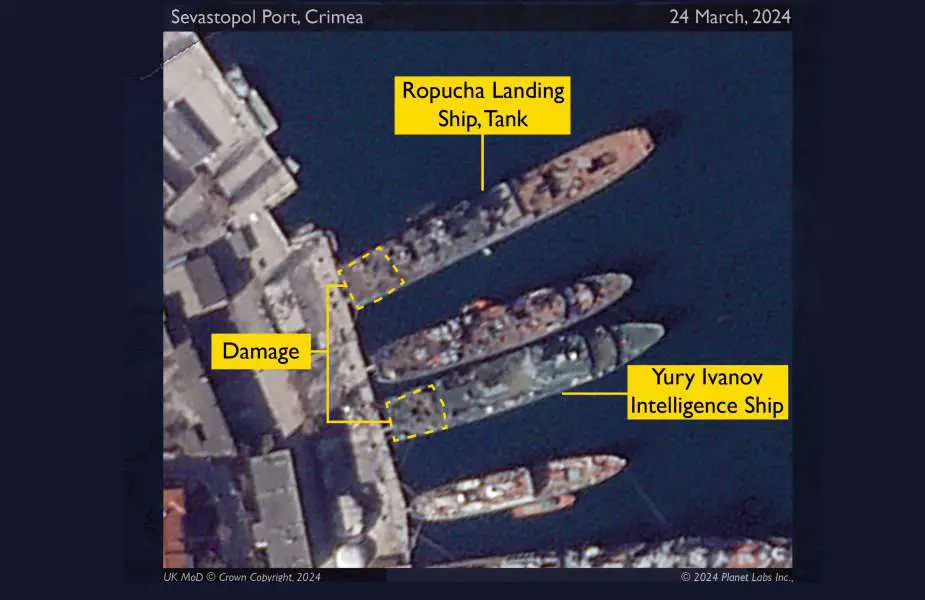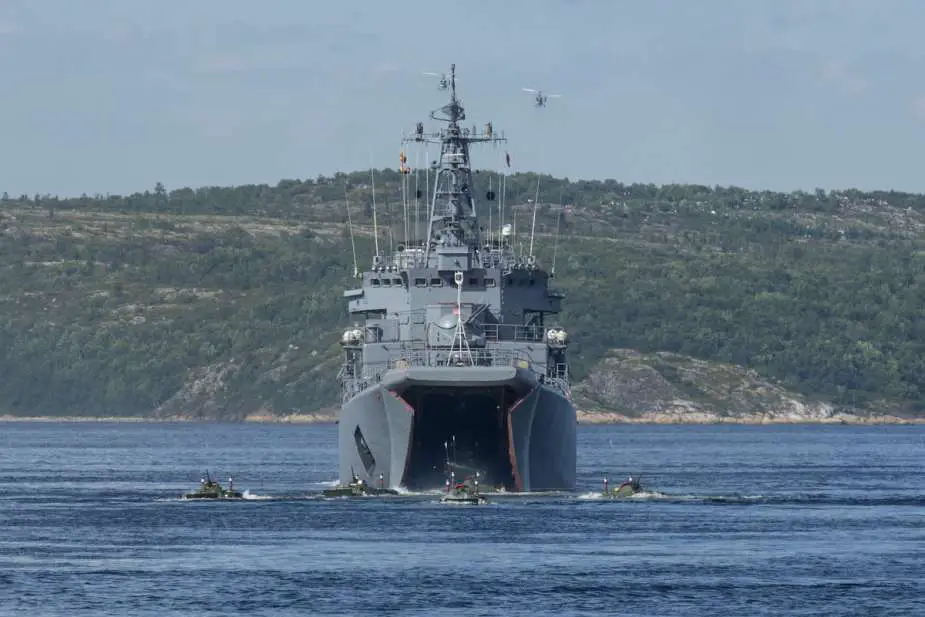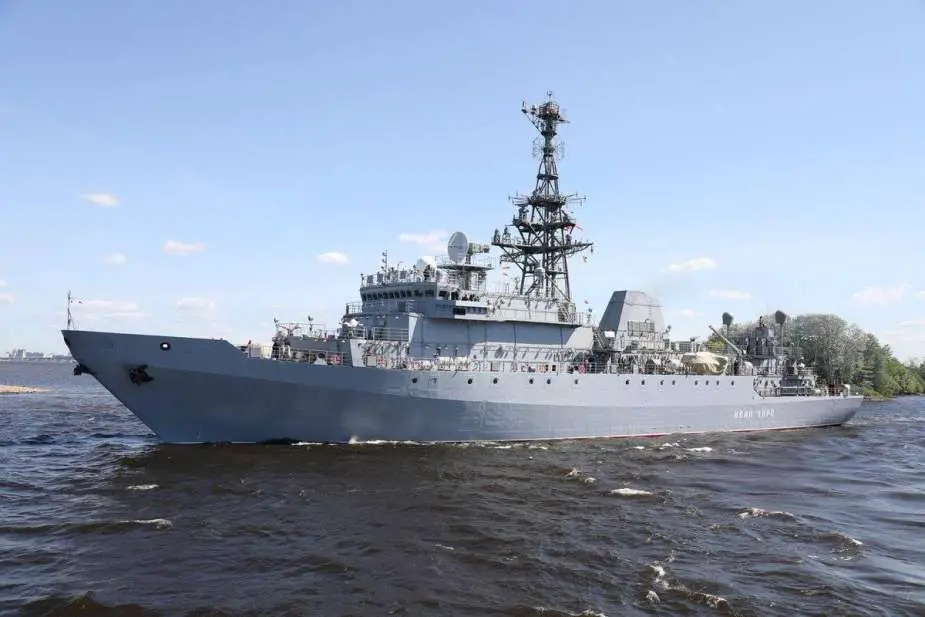On March 29, 2024, the British Ministry of Defense (MoD) Intelligence Services released satellite imagery that confirms the aftermath of a series of targeted strikes by the Ukrainian Armed Forces against the Russian Navy naval base in Sevastopol, Crimea. The strikes, which took place on March 24, 2024, have resulted in considerable damage to key components of the Russian Navy's operational capabilities in the region including two Ropucha-class large landing ships and one Yury Ivanov-class intelligence ship.
Follow Navy Recognition on Google News at this link
 A Satellite image released by the British MoD Intelligence Services shows that two Russian navy ships have been damaged after the March 24, 2024 attack by Ukrainian armed forces. (Picture source: British MoD)
A Satellite image released by the British MoD Intelligence Services shows that two Russian navy ships have been damaged after the March 24, 2024 attack by Ukrainian armed forces. (Picture source: British MoD)
Using Storm Shadow cruise missiles, the Ukrainian forces launched a precision attack on March 24, 2024, significantly impacting two of Russia’s Ropucha-class large landing ships, the Yamal and the Azov. These vessels are crucial for amphibious assault operations, and their incapacitation marks a severe blow to the Russian military's logistical and operational flexibility.
The Storm Shadow is a long-range, air-launched cruise missile developed jointly by the United Kingdom and France. It's designed to engage high-value, well-defended targets from a considerable distance, thereby minimizing the risk to the launching aircraft. With a range of over 250 kilometers (about 155 miles), the Storm Shadow carries a powerful conventional warhead and is known for its precision, capable of striking targets with high accuracy due to its advanced guidance system, which includes GPS and terrain reference navigation. Its stealthy design allows it to evade radar detection, making it particularly effective against strategic targets such as command and control centers, airbases, radar installations, and bunkers. The missile has been in service since the early 2000s and has been used in various military operations, demonstrating its capability to strike deep behind enemy lines with significant destructive power.
In addition to the damage inflicted on the landing ships, the Ukrainian strikes have also compromised a critical communications hub in Sevastopol. Detailed analysis of the satellite imagery revealed that one building within the hub suffered structural damage, including a partial roof collapse, while two other buildings experienced significant blast damage. This disruption in communications infrastructure is likely to pose substantial challenges to the Russian Navy's coordination and response capabilities in the Black Sea.
Moreover, the imagery confirmed damage to a Yury Ivanov-class intelligence ship, a vessel integral to Russia's maritime intelligence-gathering efforts. The impairment of such an asset further diminishes Russia’s surveillance and intelligence operations in a region already fraught with strategic tensions.
Following these strikes, there has been a notable shift in Russian naval operations. High-value Russian vessels, typically reliant on the port facilities in Sevastopol for maintenance and resupply, have been compelled to relocate to alternative ports further east. This relocation underscores the effectiveness of the Ukrainian strikes in forcing a strategic reevaluation by the Russian Navy.
The Ukrainian Air Force's operations on March 24, targeting among others the Black Sea Fleet (BSF) Communications Centre, have significantly contributed to undermining the operational stability and power projection capabilities of the Russian Black Sea Fleet in Crimea. Despite efforts by Russia to mitigate these losses and adapt to the evolving tactical situation, Ukraine’s successful strikes signal a noteworthy shift in the dynamic of military engagements in the region, emphasizing Ukraine's continued resolve and capability to challenge Russian military actions effectively.

The Ropucha-class also referred in Russia as Project 775 in Soviet is a large landing ship. (Picture source Wikimedia)
The Ropucha-class, also known as Project 775, are large landing ships designed and built by the Soviet Navy and later by the Russian Navy. These amphibious assault ships are primarily used for beach landings, capable of transporting troops, tanks, and other military vehicles directly onto shore without the need for port facilities. This makes them an integral part of naval operations, especially in scenarios requiring rapid deployment and logistical support for ground forces in coastal areas.
Ropucha-class ships are characterized by their large, flat decks and a bow ramp that allows for the direct disembarkation of troops and equipment. They can carry a significant payload, including multiple tanks, armored vehicles, and several hundred troops. These ships are also armed with defensive weaponry to protect against air and sea threats, though their primary role is logistical rather than combat.
Since their introduction in the late 1970s, Ropucha-class ships have seen extensive service in the Soviet and Russian navies, and they have been involved in numerous military operations and exercises. Their ability to project power and support amphibious assaults across coastlines makes them valuable assets for any naval force operating in littoral zones. Despite their age, these ships continue to be an important component of Russia's naval capabilities, reflecting their robust design and adaptability to various mission profiles.
The Yury Ivanov-class intelligence ship, also known as Project 18280, is a series of Russian naval vessels designed for signals intelligence (SIGINT) and electronic warfare. Launched in the late 2000s, these ships serve the primary role of gathering intelligence from adversaries through the interception of communications and electronic signals, thereby playing a crucial part in the Russian Navy's reconnaissance and surveillance operations. Equipped with advanced electronic equipment and antennas, the Yury Ivanov-class vessels are capable of operating in both open seas and near coastal areas, providing a comprehensive intelligence-gathering capability that supports Russian military operations and strategic planning. Their deployment underscores the importance of electronic and signals intelligence in modern naval warfare, offering strategic insights and early warnings about potential threats.

The Yury Ivanov-class intelligence ship is a Russian naval vessel designed for signals intelligence (SIGINT) and electronic warfare. (Picture sourcde Facebook)



